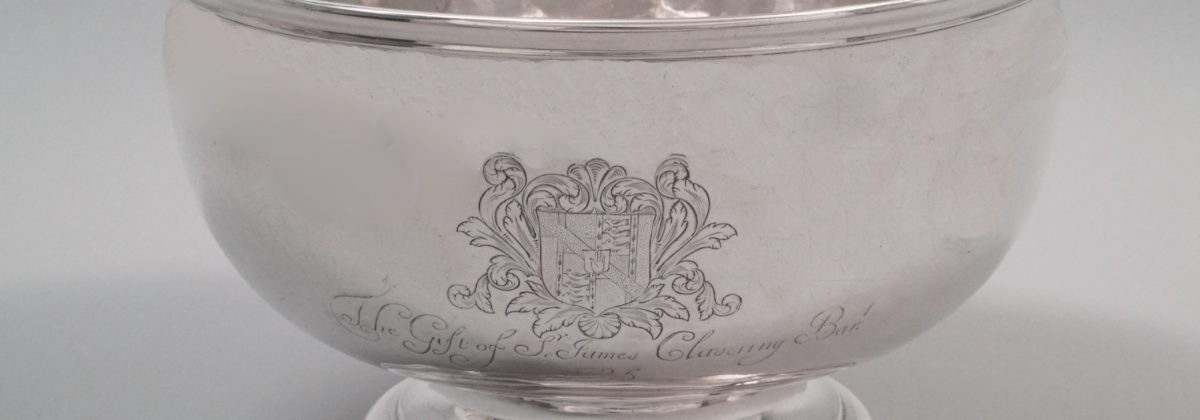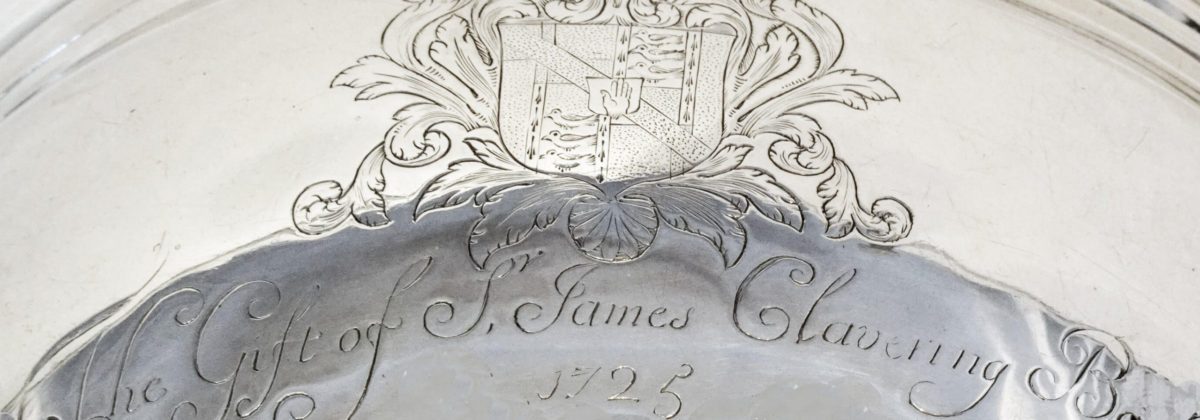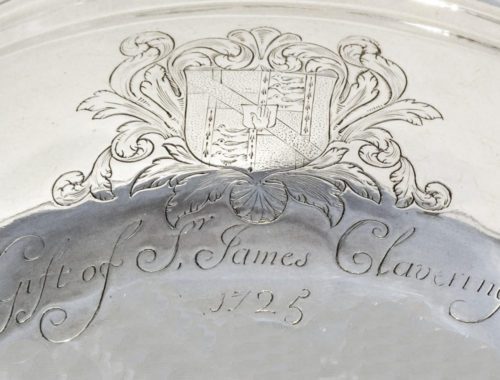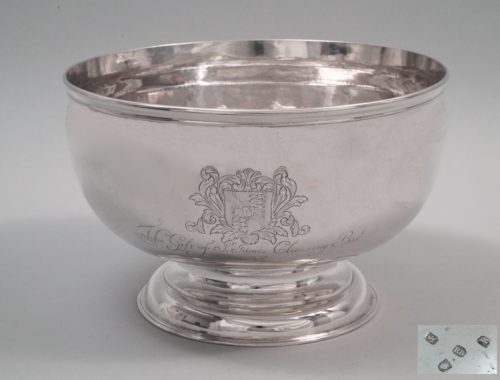Object Number: #812
London 1724/25
Maker: Richard Bayley
City hallmark: crowned leopard for London (Jackson 1921: 85)
Maker’s mark: monogram “RB” in a shield for Richard Bayley (Grimwade Nr. 116)
Assay mark: Lion passant (Jackson 1921: 85)
Date letter: „I“ for 1724/5 (Jackson 1921: 85)
Height: 15,5 cm (6,1 in.); Dm. 23,5 cm (9,25 in.); Weight: ca. 1.180 gr. (41.623 oz)
Detailed Information
George II Silver Punch Bowl
The punch bowl is standing on amoulded, domed foot and has a slightly indented upper rim. The corpus is – as usually by these vessels – bulbous. On the front side, a crest and a dedication reading: “The gift of Sr. James Clavering Bart 1725”. The crest belongs to the family Clavering, and especially to Sir James Clavering of Axwell, 4th Baronet. He matriculated in 1724 at the Queens College in Oxford. Sir James Clavering remained unmarried and passed away in 18th May 1726, during a journey abroad. He was inherited by his oncle.
Punch and Punch Bowls
Punch was a popular alcoholic drink in England since the early seventeenth century. The politician Sir Alexander Radcliffe (1608-1654) wrote in his poem “Bacchinalia Coelestia: A poem, in praise of punch” the following on this drink:
The Gods and the Goddesses lately did Feast,
Where Ambrosia with exquisite sawces was drest:
The Edibles did with their qualities suit;
But what they did drink, did occasion dispute.
‘Twas time that Old Nectar should grow out of fashion,
A Liquor they drank long before the Creation.
When the Sky-coloured Cloth was drawn from the Board,
For the Christalline Bowl great Iove gave the Word.
This was a Bowl of most heavenly size,
In which Infant-Gods they did use to baptize.
Quoth IOUE, we’re inform’d they drink Punch upon Earth,
By which Mortal Wights out do us in Mirth;[…]
The popularity of the drink lied certainly also in its ingredients. The punch was a mixture of citrus fruits (e.g. lemon), spices (like e.g. nutmeg), sugar, spirits (like e.g. rum) and water. The origin of the word “punch” lies most probably to the Hindi word “pac” meaning “five” and making thus reference to the five ingredients of the alcoholic beverage used initially in India.
Spices, sugar and spirits brought the connection to the West and East Indies as well as to the British interest over these geographical areas. This explains also its wide acclaim since the early modern period in Britain. This is further supported by the fact that the punch and the punch bowl represented a symbol for the British support of West Indies in the eighteenth century (through the Whigs), as one engraving of William Hogarth in 1732 reveals.
Punch stayed popular for almost 250 years and could be drunk hot or cold. In the Americas, during the eighteenth century, punch was a favourite alcoholic drink as well, as the painting of John Greenwood (1727-92) “Sea Captains Carousing in Surinam”, c. 1752-58 (in the Saint Louis Art Museum) well shows. Relatively late, in the nineteenth century, French gentlemen also showed a preference to punch over wine, as is reported also by Brillat-Savarin (1825, p. 168).
In England, one can see early punch bowls made out of glass (like an example in the collections of the Victoria and Albert Museum from ca. 1680). Besides the vessels made in silver and which offered a large surface for personalising the object through decorative patterns and the engraving of coat of armsor offering sayings, there are also ceramic punch bowls, while the Meissen Manufacture also produced such vessels.
Maker
Richard Bayley was son of Anthony Bayly of Hampton, near Highworth. He apprenticed to Charles Overing from 1699 to 1704 and became a master maker on 1706. His first entered mark dates since 1708. His name is traced in a petition in 1711 about the necessity of seven years of apprenticeship on behalf of foreigners (mostly Huguenots) who gave their work for assaying. Richard Bayley produced good quality silver, with decoration, like tankards, jugs, coffee and tea-pots. Some of his fine works are in the Victoria & Albert Museum (s. Grimwade 1990: 434-5).
Helga Matzke shows an exceptional tea kettle on stand by this maker.
Literature
Grimwade, Ar., London Goldsmiths 1697-1837. Their marks and lives from the original registers at Goldsmiths’ Hall and other sources, GB: Faber and Faber, 1990 [Grimwade3].
Jackson, Ch., J., English Goldsmiths and their marks, London: MacMillan and Co. Limited, 1921.
Johnson, Ed. Kimber, The Baronetage of England:, Containing a Genealogical and Historical Account of All the English Baronets Now Existing: with Their Descents, Marriages, and Memorable Actions Both in War and Peace. […], vol. 2, London: G. Woodfall, J. Fuller, E. Johnson, Hawes, Clarke and Collins, W. Johnston […], 1771, (p. 204).
Brillat-Savarin, Jean Anthelme, Physiologie du goût, ill. par Bertall, 1848 : G. de Gonet, Paris.
Ph. Glanville, S. Lee (eds.), The Art of Drinking, V & A Publications: London, 2007.





